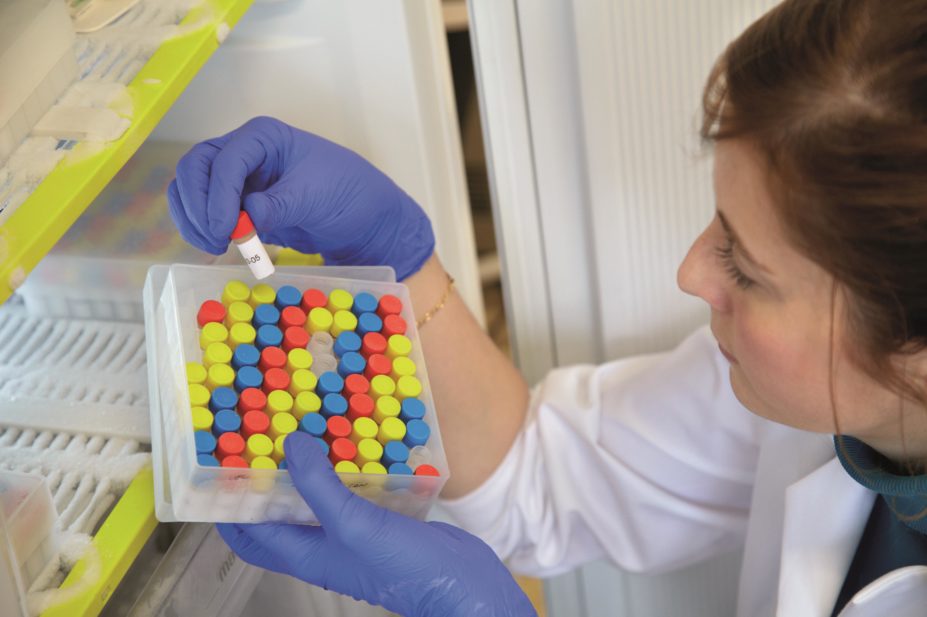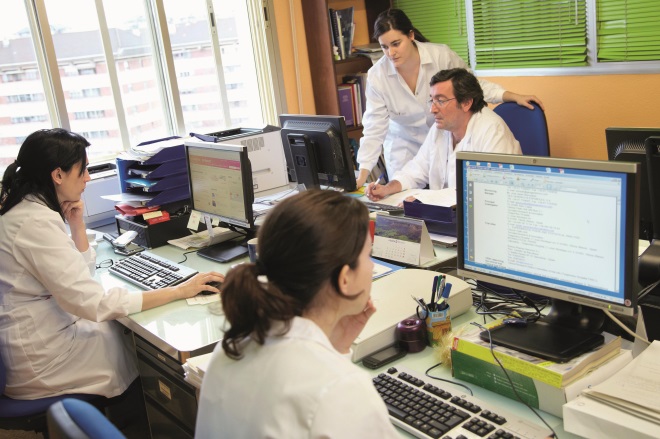
age fotostock / Alamy
The cost of getting a drug to market is often lamented; in 2014, the final bill was estimated at a whopping US$2.6bn. But a lack of cash is not the only sticking point for getting new medicines to the people who need them. Clinical trials and the rules that govern them are coming under pressure for an overhaul. Trials are struggling to recruit patients, often do not reflect the way a drug would be used in the real world, and are subject to complicated regulatory systems that differ from country to country.

Sarah Garner, associate director of research and development at the UK’s National Institute for Health and Care Excellence
“It’s not an efficient system,” says Sarah Garner, associate director of research and development at the United Kingdom’s health technology assessment (HTA) organisation the National Institute for Health and Care Excellence (NICE) in London. At the moment that system involves first testing a potential new treatment on animals, then, if these tests are successful, there are at least three, often lengthy, clinical studies in humans before a drug company submits the results along with its request for authorisation. At this point the regulators review the data before making a decision. Next, the body that pays for the drug (the HTA organisation in each country) has to decide whether to fund the costs of the treatment. If they give the go-ahead, patients can finally be prescribed the drug for its approved use.
However, changes are afoot, with a number of projects around the globe addressing problem areas in the clinical trial system. The need for better, and faster, access to drugs for patients, as well as value for money, is driving these schemes.
Recruitment and retention
One problem facing clinical trials is finding willing participants: for a study to be effective, it needs the right patients to enrol, and in large enough numbers. “Recruitment and retention of recruited participants are the greatest threat to trials,” says David Richards, a mental health researcher from the University of Exeter, UK. Richards recently led a study called DiReCT, looking at improving recruitment to trials related to mental health. The study tested out a system whereby patients seeing clinicians for help with anxiety and depression in Devon, UK, were asked to join a large cohort from which they could be randomly selected for numerous trials. Richards and his team found that most patients were willing to participate in the scheme; it was actually a reluctance from clinicians to ask for their involvement that was holding back recruitment.
Recruitment and retention of recruited participants are the greatest threat to trials
“Ironically enough, we don’t know much about how to improve recruitment, because there are very few trials of different methods,” says Peter Bower, a primary care researcher from the University of Manchester, UK. Bower is running a project called Systematic Techniques for Assisting Recruitment to Trials (START), which hopes to address this, with the ultimate goal of improving on the unnerving statistic that 45% of all publicly funded trials in the UK fail to recruit enough patients.
Often patients who are keen to participate in trials are unsure how to get involved. The US-based online patient network Patients Like Me (PLM) was set up in 2004 to plug that gap, helping patients get more involved in studies that might benefit them. PLM founders Jamie and Ben Heywood, along with a family friend, were motivated to start the network after a frustrating few years trying to help their brother, who had been diagnosed with amyotrophic lateral sclerosis, or motor neurone disease, get access to new therapies.
The brothers noticed that online chatrooms were full of patients discussing their experiences with clinical trials, and decided to bring them together in one place. Since then the company has gone on to collaborate with major pharmaceutical companies, developing ways to include data charting real patients’ experiences within clinical trials.
“One of the rabbit holes we’ve fallen into is obsessing over things that can be measured, instead of listening to patients,” says Paul Wicks, PLM’s vice president for innovation. “Until now, pharma has not designed clinical trials by speaking to patients about what’s important to them,” he says.
PLM is a platform for patients from around the world, with specific conditions, to connect with each other; but it is also a resource for researchers investigating these conditions. Success stories include a PLM research project looking at short-term fluctuations in the severity of symptoms in Parkinson’s patients through participants self-reporting how they were doing on a standardised questionnaire. The study found that the disease is more variable than had previously been thought[1]
. PLM also collaborated on a recent study with Cambridge, Massachusetts-based biotech company Biogen, which gave 250 multiple sclerosis patients Fitbit monitors to help manage their condition. By using their site to get the word out, PLM was able to recruit the patient sample within 24 hours.
I’d question whether there are any aspects of the drug development process in which patients should not have a strong voice
Wicks says that PLM is one of a few organisations challenging the view of patients as guinea pigs — passive subjects in an experiment. As an example, he cites the fact that the British Medical Journal now has patients as peer reviewers for its articles. But “it’s a small number of us and we’re going to have to persuade and convince lots of other people to get them onboard and out of their previous habits of the way things are done”, he says. PLM would like to see patients have input into issues such as which areas the pharmaceutical industry should invest in, which products they should be taking forward from their portfolios, and what is a tolerable side effect. “I’d question whether there are any aspects of the drug development process in which patients should not have a strong voice,” says Wicks.
Regulatory constraints
Recruitment and patient input into trials is not the only the problem, though. Trials are necessarily constrained by regulations in order to get a drug safely to market. But this can make it hard for patients in desperate need of a treatment to get access to it as companies jump through regulatory hoops that vary from country to country, often needing to gather different sets of data to get the same drug approved in different markets across the world.

Source: age fotostock / Alamy
Researchers are investigating ways of gathering data about the experiences of patients outside of a controlled trial setting to help determine a drug’s effectiveness
In Europe, this problem is being dealt with on a continent-wide level with a number of projects. The GetReal project is one, funded by the Innovative Medicines Initiative, an EU-backed public–private consortium including pharmaceutical companies, HTA authorities, academics, regulators and patient groups. GetReal is investigating ways of gathering data about the experiences of patients outside of a controlled trial setting — so called real-world evidence — to help determine a drug’s effectiveness. The aim is to incorporate these data early on in drug development, even before the product is launched, helping pharmaceutical companies to make better decisions down the line and to speed up the HTA process.
For any project like GetReal to take off, pharmaceutical companies have to know that they are still going to be providing the regulators with what they need to pass a drug for use. However, early data can be helpful: there are options for getting a drug approved for market before the usual swathe of late-stage clinical trials are completed.
Different countries have their own approaches to this concept. In November 2014, Japan implemented a law that allows companies developing regenerative medicines — stem-cell technologies — to apply for marketing authorisation much earlier than usual. If some evidence of safety has been shown, and there are signs that the treatment works, companies who win approval can legally market their drug, albeit for a limited time period of up to seven years before the evidence would need to be looked at again. However, no one has done this yet: “To date it’s not been put to use,” says Douglas Sipp, research specialist at the RIKEN Center for Developmental Biology in Kobe, Japan.
And, although this change in the law could mean speedier access to stem-cell therapies, Sipp is concerned that Japanese regulators have not thought through the safety implications. “Unlike small molecules, which are metabolised, many regenerative products are intended to survive and function in the body for years,” he says.
Consequently, a tight regulatory regime might be important to avoid any problems with safety. Sipp is also concerned at what happens after those seven years are up, saying it would be hard to run a truly randomised trial if the drug were already on the market.
In the United States, pharmaceutical companies have a number of options if they want to speed up the regulatory process. In 2012, the US Food and Drug Administration (FDA) introduced the latest of these — a ‘breakthrough therapy’ designation designed to speed up the process of authorising drugs that show promise in early studies and that could make a big difference to patients suffering from serious or life-threatening conditions. Under the scheme, the FDA is committed to reviewing applications to have a drug designated as a breakthrough therapy within 60 days, compared with a target of ten months for standard review.

Douglas Sipp, research specialist at the RIKEN Center for Developmental Biology in Kobe, Japan
Since the designation was introduced in 2012, 21 approvals have been made. The scheme is very different to Japan’s latest stem-cell rules, says Sipp. “The FDA will make exceptions. That’s very different to making a whole category eligible,” he says.
The FDA has three additional fast routes to approval: fast track, priority review, and accelerated approval. These routes are popular for so-called new molecular entities (NMEs), drugs that contain an active ingredient that has never before been marketed in the United States. So far in 2015, ten NMEs have been approved by the FDA, including products for multiple myelomas, psoriasis, breast cancer and neuroblastoma.
The European Medicines Agency (EMA), a London-based EU-wide drug regulation organisation, already has a system of conditional approval for drugs targeting diseases with unmet needs. In 2014, the EU’s first stem-cell therapy was given the go-ahead using this method. The drug, Holoclar, is used to treat a condition that can cause blindness: limbal stem-cell deficiency, which can happen after an eye is damaged by physical or chemical burns.
In addition to conditional approval, the EMA is trialling something it is calling ‘adaptive pathways’. A route to fast drug approval, adaptive pathways would enable a medicine to be used in a particular patient subgroup, with the rest of the required clinical data for approval gathered once the drug is on the market. Later, approval might be widened to include other patient groups. “The adaptive pathways process addresses the entire life span of a product,” explains Magda Chlebus, director of science policy at the European Federation of Pharmaceutical Industries and Associations in Brussels.
The adaptive pathways process addresses the entire life span of a product
Garner says that eligible drugs are likely to be initially approved for niche applications, and that in the EMA’s pilot scheme, officially called Medicines Adaptive Pathways to Patients (MAPPs), ten drugs are already going through the process, although details remain confidential. “These are drugs that don’t fit the standard process,” says Garner. She explains that companies involved in the pilot are realising that they need to think about their HTA strategies sooner, and are changing the order in which they do things. “We’re already seeing benefits,” she says. “We’re changing how people think.”
Personalised medicine
These niche markets herald another change with implications for the future of clinical trials: the move from broad-use, blockbuster medicines to those that will serve just a few patients with a rare genetic mutation or disease. Personalised medicine is the extreme of this approach, and will necessitate a move away from a limited number of large trials to a large number of small trials, says Craig Lipset, Pfizer’s head of clinical innovations, based in New York. “We need to develop [a] sustainable clinical trial infrastructure such [as] to enable efficient small studies in the future,” he adds. For example, Pfizer has embarked on a partnership with Cancer Research UK and AstraZeneca, both based in London, to create a pioneering clinical trial for patients with advanced lung cancer. The trial splits patients into small groups on the basis of their cancers having shared genetic features, and has a ‘multi-armed’ design so that up to 14 drugs supplied by Pfizer and AstraZeneca can be trialled at once.
The number of new initiatives being pursued is an indication that things will continue to evolve rapidly, and the clinical trial of the future should deliver better, and faster, access to drugs for patients across the world. But throughout the changes, we should not forget the essential value of the system. “The only solution to ensuring that the best medicines get to the right patients is through clinical trials,” says Lipset. “That is the only way we will generate the evidence to support precision medicine. Clinical trials are a source of evidence; they are not the barrier but the solution.”
References
[1] Little M, Wicks P & Vaughan T. Quantifying short-term dynamics of Parkinson’s disease using self-reported symptom data from an internet social network. Journal of Medical Internet Research 2013;15:e20.


